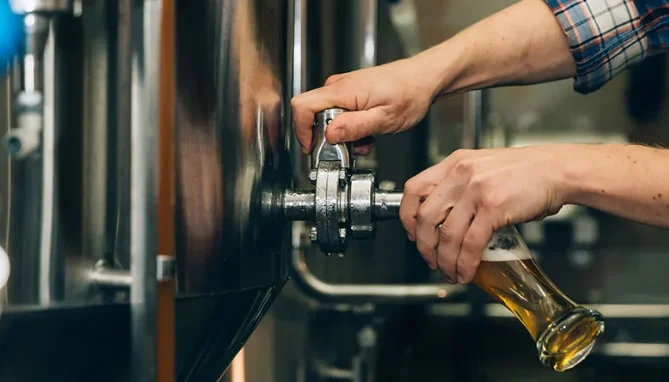Hop separation is a critical step in the brewing process that significantly impacts the quality, flavor, and clarity of the final beer product. As hops are a vital ingredient in beer, providing bitterness, aroma, and stability, their effective separation and utilization are paramount. This article explores the importance of hop separation, the different methods used, and their implications for brewing.
The Role of Hops in Brewing
Hops are the flowers (also called seed cones or strobiles) of the hop plant Humulus lupulus. They are used primarily as a bittering, flavoring, and stability agent in beer, contributing to a range of flavors and aromas such as citrus, pine, and floral notes. Additionally, hops have preservative qualities that help maintain the beer’s freshness.
Importance of Hop Separation
During the brewing process, hops are added at various stages to impart their desired characteristics. However, once they have imparted their flavors and bitterness, the solid hop materials need to be separated from the wort (the liquid extracted from the mashing process) to ensure a clean, clear beer. Effective hop separation has several benefits:
Clarity: Removing hop particles ensures the beer is visually appealing and free from haze.
Flavor Control: Ensuring only the desired flavors from hops remain in the beer, while removing any unwanted bitterness or vegetal flavors.
Stability: Reducing the amount of residual hop material can improve the stability and shelf life of the beer.
Ease of Filtration: Effective separation makes subsequent filtration steps easier and more efficient.
Methods of Hop Separation
Several methods are used to separate hops from wort, each with its advantages and challenges. The choice of method often depends on the scale of production, the type of hops used, and the desired characteristics of the final product.
- Whirlpool Separation
Whirlpool separation is a widely used method in commercial brewing. After boiling, the wort is pumped into a whirlpool tank where it is swirled rapidly. This centrifugal action forces the hop solids and trub (protein particles and other solids) to the center of the tank, forming a cone that can be easily removed.
Advantages:
- Efficient at separating a large volume of solids.
- Minimal oxygen pickup, preserving the beer’s quality.
- Can be integrated into continuous brewing operations.
Disadvantages:
- Requires specific equipment (whirlpool tank).
- Not as effective for smaller particles, requiring further filtration.
- Hop Backs
A hop back is a vessel fitted with a strainer, used to separate hops from wort. After boiling, the wort is pumped through the hop back, where hop solids are trapped by the strainer, allowing the clarified wort to pass through.
Advantages:
- Provides an opportunity for additional hop aroma extraction.
- Simple and effective for smaller batches.
Disadvantages:
- Can be challenging to clean.
- May require frequent replacement of straining elements.
- Centrifugation
Centrifugation involves using a centrifuge to rapidly spin the wort, separating solids from the liquid through centrifugal force. This method is highly effective and can be used to separate both hop solids and yeast.
Advantages:
- High efficiency in separating even fine particles.
- Can be used at various stages of the brewing process.
Disadvantages:
- High initial equipment cost.
- Requires regular maintenance and operation expertise.
- Filtration
Filtration can be used in conjunction with other methods to ensure complete removal of hop solids. Filters can range from simple mesh screens to complex plate and frame filters or diatomaceous earth filters.
Advantages:
- Versatile and can be tailored to different needs.
- Effective at producing clear, bright beer.
Disadvantages:
- Filters can clog and require regular cleaning.
- Potential for oxygen pickup if not managed properly.
Innovations in Hop Separation
The brewing industry continues to innovate in hop separation techniques to improve efficiency and beer quality. Some notable advancements include:
- Hop Pellets and Extracts
Using hop pellets and extracts can reduce the need for extensive separation processes. These forms of hops dissolve more completely in the wort, leaving fewer solids to be removed.
Advantages:
- Consistent and predictable hop utilization.
- Reduced waste and easier separation.
- Membrane Filtration
Membrane filtration technology is being adapted for brewing, providing fine separation without the need for traditional filters. This method uses semi-permeable membranes to remove hop solids and other particulates.
Advantages:
- High precision and efficiency.
- Reduced risk of contamination.
- Automation and Smart Systems
Automated separation systems with smart controls can optimize the separation process, adjusting parameters in real-time to ensure maximum efficiency and quality.
Advantages:
- Increased consistency and repeatability.
- Reduced labor and operational costs.
Impact on Beer Quality
Effective hop separation is crucial for producing high-quality beer. It affects not only the clarity and appearance of the beer but also its flavor, aroma, and stability. By carefully managing hop separation, brewers can ensure that the final product meets the desired specifications and provides an enjoyable experience for consumers.
Conclusion
Hop separation is a fundamental aspect of the brewing process that significantly impacts the quality of the final beer. Through various methods such as whirlpool separation, hop backs, centrifugation, and filtration, brewers can effectively remove hop solids and ensure a clean, clear product. Innovations in hop separation technology continue to enhance efficiency and beer quality, making this an exciting area of development in the brewing industry. Whether you are a homebrewer or a commercial producer, understanding and implementing effective hop separation techniques is essential for crafting exceptional beer.

Ruby Stauffer is a prominent technology blogger known for her insightful analysis and in-depth reviews of the latest tech trends and gadgets. Her blog has become a go-to resource for tech enthusiasts seeking reliable information and expert opinions on the ever-evolving world of technology.

